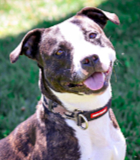EXCESSIVE BARKING
- This topic has 0 replies, 1 voice, and was last updated 16 years, 4 months ago by
Mackenzie’s Admin.
-
AuthorPosts
-
January 22, 2009 at 5:20 pm #309
Mackenzie’s Admin
MemberDogs bark-a lot. They bark when they want something, when they’re having fun, when they feel frustrated, and when defending their territory-to name just a few reasons. If you think your dog barks excessively, your first job is to find out why. Read what The ASPCA experts at the Animal Behavior Center recommend.
Excessive barking is nothing new. Dogs appear to enjoy barking, and they do so for various reasons. They bark when they want something, when they say “hello,” when they are having fun, when they are startled or alarmed, when they are defending their territory or threatening someone, when they are frustrated, and when they hear other dogs barking. Unfortunately, a dog who barks incessantly can drive the family crazy—and disturb the entire neighborhood.
Many owners can identify why their dog is barking, just by hearing the specific bark. If you want to reduce your dog’s barking, it is imperative to determine the dog’s reason for barking. Understand that it usually takes time to teach a dog to bark less. It is not realistic to expect a quick fix or to expect that the dog will stop barking altogether. Your goal should be to decrease the amount of barking. Bear in mind that some dogs are more prone to barking than others. In addition, some breeds are known as “barkers,” and it may be more difficult to decrease barking in individuals of these breeds.
The most common reasons why dogs bark:
– Territorial or protective defense
– Distress vocalizations due to fear or separation anxiety
– Excitement or greeting
– During play
– To gain attention or to make requests
– Frustration
– Socially facilitated barking (hearing other dogs bark)
– Compulsive behaviorWhat not to do:
– Do not encourage the dog to bark at passers by or people coming to the door (by saying, “Who’s there?,” for example, or getting up and looking out the window, you are encouraging the dog to bark).
– Do not punish the dog for barking at certain sounds (car doors slamming, kids playing in the street) while encouraging him to bark at other sounds (people at the door). You must be consistent!
– Never use punishment procedures for a dog who is barking from fear or anxiety, unless on the advice of a Certified Applied Animal Behaviorist or Veterinary Behaviorist. This could make the dog feel worse, which could in turn cause the barking to escalate.
– Never use a muzzle or Husher™ to keep a dog quiet for long periods of time or while a dog is unsupervised. As the dog cannot eat, drink, or cool himself while wearing a muzzle, this would be extremely cruel.
– Never tie a dog’s muzzle closed with rope, cord, or rubber bands. This is dangerous, painful, and inhumane.Territorial Barking:
Dogs who bark to alert others to the presence of visitors and/or to scare off intruders use what is called an alarm bark. They bark when they see or hear people coming to the door, and they may even react to the sights and sounds of people and dogs passing by the home. Some dogs are especially raucous when they see people or dogs from the car. You should be able to judge from your dog’s body posture and behavior whether he’s barking to say “Welcome, come on in!” or “Hey, I see you and you’d better hit the road, you’re not welcome at my place.” If you’re dealing with a dog in the first category, follow the steps outlined for greeting barking. If you’re dealing with a dog in the latter category who isn’t friendly to people, you will likely be more successful teaching the dog to associate the presence of strangers and passersby with good things, such as food and attention (see Counter Conditioning Instructions, below). If you think your dog poses a threat to people near your property or visitors to your home, seek assistance from a Certified Applied Animal Behaviorist, a Veterinary Behaviorist, or a Certified Professional Dog Trainer.What to do:
– Prevent the dog from being exposed to the things that trigger him to bark. You should block access to windows, and cover them so he can’t see out. Play background music to mask outside sounds, change the sound of your doorbell, and bring him in from the yard whenever he barks.
– Counter Conditioning Instructions #1: If the dog continues to bark despite your efforts to block his exposure to things, teach him that when someone comes to the door or passes by the property, he is permitted to bark until you say “Quiet.” Allow him to bark 3-4 times, say “Quiet,” (avoid shouting), go to the dog and gently hold his muzzle closed with your hand and repeat “Quiet,” call him away from the door or window, ask him to sit, and give him a treat. If he stays beside you and remains quiet, continue to give him frequent treats for the next few minutes (until the stimulus is gone). If he resumes barking right away, repeat the sequence. Go through the same steps if the dog is barking at passersby from the yard.
– Counter Conditioning Instructions #2: If the above procedure is ineffective after 10-20 attempts, allow the dog to bark 3-4 times, say “Quiet” (avoid shouting), and make a startling noise by shaking an empty soda can filled with pennies or a set of keys. He should react to the sound by stopping what he’s doing. Call him away from the door or window, ask him to sit, and give him a treat. If he stays beside you and remains quiet, continue to give him frequent treats for the next few minutes (until the stimulus is gone). If he resumes barking right away, repeat the sequence. If this doesn’t work after 10-20 attempts, you will need to seek assistance from a Certified Applied Animal Behaviorist, a Veterinary Behaviorist, or a Certified Professional Dog Trainer.
– Counter Conditioning Instructions #3: If the dog barks at people and other dogs during walks, distract the dog with special treats before he begins to bark. Show the dog the treats by holding them in front if his nose (soft treats are best) and encourage him to nibble at the treats while he is walking along, past the person or dog who would normally cause him to bark. Some dogs do best if you ask them to sit as the person/dog passes by, while other dogs prefer to keep moving. Make sure you praise and reward the dog with treats every time he elects not to bark.
– It may help to have the dog wear a head halter during occasions when the dog is likely to bark (on walks, in the home, etc.). Your dog should only wear the halter when you can supervise him. A halter can have a distracting and/or calming effect, and make him less likely to bark. Make sure you reward him for not barking.
– If the dog is engaging in territorial barking primarily in the yard, keep the dog in the house during the day and supervise him when he is in the yard.
– If the dog is engaging in territorial barking in the car, teach the dog to ride in a crate while in the car. This restricts the dog’s view and may reduce his motivation to bark. If this is not feasible, try having the dog wear a head halter.Greeting Barking:
If your dog barks at people coming to the door, at people or dogs walking by the property, at people or dogs he sees on walks, and at people or dogs he sees through the fence—and the barking is accompanied by whining, tail wagging, and other signs of friendliness—your dog is barking to say hello. He may very likely bark in the same manner when family members come home.What do to:
– Keep greetings low key. Teach the dog to sit and stay when meeting people at the door so he has something to do aside from barking. This should reduce his excitement.
– If your dog likes toys, keep a favorite toy near the front door and encourage your dog to pick up the toy before he greets you or guests. If the dog learns to hold a toy in his mouth, he’s less inclined to bark. He will likely still whine, though.
– On walks, teach your dog to walk calmly past people and dogs without greeting them. To do this, follow the Counter Conditioning Instructions #3, above.Play Barking:
Some dogs are particularly noisy when they play with people or with other dogs. If you have multiple dogs and they like to bark while they play, put them outside so they don’t bother you. If they bother the neighbors, bring them inside and separate them during times when you can’t tolerate the barking. Encourage the dogs to play with toys so they have something in their mouths. If your dog barks while playing with you, simply play different games—if he barks while wrestling with you, teach him to play tug-of-war or fetch games. It’s unfair to expect dogs not to play, so make arrangements for your dog to play (and bark) at times when it won’t disturb people.Attention Seeking/Making Requests:
One of the reasons why we love dogs is that they are so expressive. Dogs find ways to let us know their needs, and often this is by barking or whining. Indeed, we find it desirable when the dog barks to ask to go outside to eliminate, or to request that his water bowl be filled. It is less desirable, however, when the dog barks to demand anything and everything, needed or not! This pattern of barking does not happen by accident; a demanding, noisy dog has been taught to be this way! If you want your dog to cease and desist, it is imperative that you consistently stop rewarding the dog for barking. Instead of trying to determine why the dog is barking, you will have to ignore the dog for barking. You may elect to stare at the ceiling, turn away from the dog, or walk out of the room. The instant the dog stops barking, you need to give the dog what he wants, whether that be attention, play, to go outside, to come in, etc. The exception to this is the dog who barks to request food—no dog should be reinforced for demanding food/treats/chew bones. That’s just plain rude! In order to be successful, you must never, ever reward the dog for barking at you again! In some cases, it is easiest to teach the dog an alternative behavior. For instance, if you don’t want the dog to bark when he needs to go out or come in, get a doggy door installed or teach the dog to ring a bell. If your dog barks to get you to play with him, teach him to bring a toy and sit in front of you. Sometimes, it’s easier to avoid problems. If your dog barks to ask you to retrieve his toys from under the sofa, fill up the space so the toys don’t get stuck beyond his reach. If your dog barks at you when you speak on the telephone or work on the computer, give him a tasty chew bone to occupy him before he starts to bark.Excitement/Frustration Barking:
Dogs often bark when they find themselves excited but thwarted from getting something they want. This could be the dog in the yard barking because he wants to get out and play with the children in the street, the dog who barks and runs the fence line with the dog next door, the dog who barks by the patio door as he watches a cat or squirrel frolicking in his yard, the dog who barks at his owner to hurry up and get his leash and go for that walk…. The most effective means of discouraging excitement/frustration barking is to teach the dog to control his impulses through obedience training. The dog is taught to wait, sit and stay before gaining access to fun activities, such as walks, playing with other dogs, or chasing squirrels. This can be a daunting task and you may need to recruit the assistance of a Certified Professional Dog Trainer. You can also discourage the presence of cats and other animals in your yard by using motion-activated devices to startle intruders, including the Critter GitterTM, the ScarecrowTM, or the ScraminalTM.Socially Facilitated Barking:
Dogs are social animals and they are prompted to bark when they hear others barking, whether in real life or on TV. You can discourage this tendency by keeping your dog indoors when other dogs are barking, by playing music to drown out the sound of other dogs, and by distracting your dog with treats or play when other dogs bark.Compulsive Barking:
There are occasional compulsive barkers who bark in situations that are not considered normal or bark in a repetitive, rigid fashion. If your dog barks repeatedly for long periods of time, apparently at nothing, he may be a compulsive barker. If your dog repeatedly barks at things that would not bother other dogs, such as shadows, light flashes, mirrors, open doors, the sky, etc., you may have a compulsive barker. If your dog also engages in other stereotypic behaviors while barking, such as spinning, circling, or jumping, he may be a compulsive barker. A good first step may be to make a change in his lifestyle. For instance, if the dog is tied up, try keeping him loose in a safe fenced area. If the dog is left alone for long periods of time, increase his exercise, mental stimulation and social contact.If you suspect your dog is a compulsive barker, please seek assistance from a Certified Applied Animal Behaviorist or a Veterinary Behaviorist; his condition may require drug therapy.
A Few Words on Anti-Bark Collars:
First and foremost: Anti-bark collars are punishment devices and are not recommended as a first choice for dealing with a barking problem, especially if the barking is motivated by fear, anxiety or compulsion. Before resorting to an anti-bark collar, you should seek advice from a Certified Applied Animal Behaviorist, a Veterinary Behaviorist, or a Certified Professional Dog Trainer.There are a variety of devices designed to teach a dog to curtail barking. Most often, these are collars that deliver an unpleasant stimulus when the dog barks. The stimulus might be a loud noise, an ultrasonic noise, a spray of citronella mist, or a brief electric shock. The collars that deliver noise are ineffective with most dogs. One study found that the citronella collar was as effective for eliminating barking as the electronic collar, and more positively received by owners. Collars that work on a microphone system to pick up the sound of a dog’s bark should not be used in a multi-dog home because any dog’s bark can activate the collar. Note that virtually all dogs become “collar-wise,” and will learn not to bark while wearing the collar.
-
AuthorPosts
- You must be logged in to reply to this topic.












































